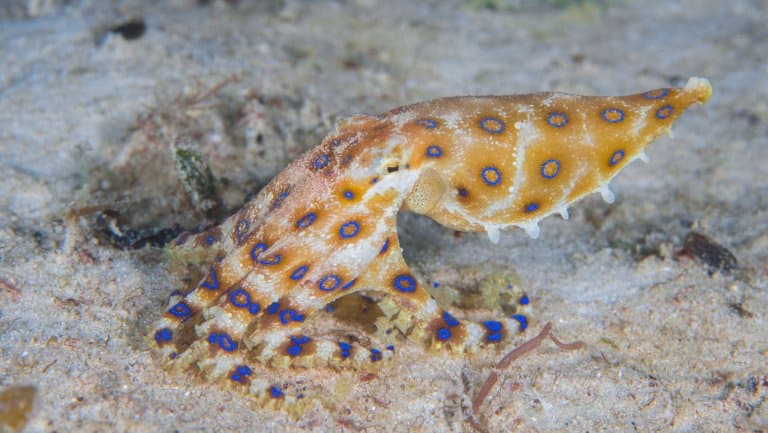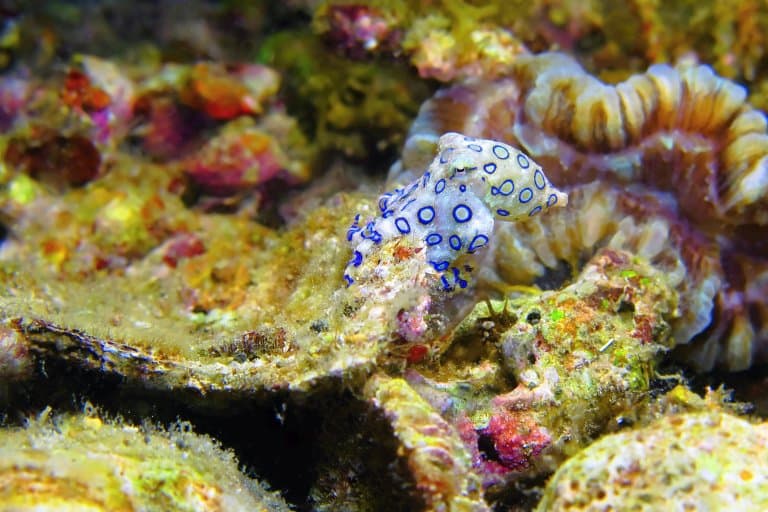Blue-Ringed Octopus Profile
The word “bro” gets thrown around a lot on the beaches of Australia. However, in some circles, hearing it exclaimed by a diver emerging from the water could mean a medical emergency.
One pretty little octopus, affectionally called BRO, has enough power to kill over twenty adults. The Blue-Ringed Octopus reinforces Australian stereotypes in more ways than one.
This highly venonmous octopus generally prefers to keep to itself in the warm reefs of the shallow waters of the Pacific and Indian Oceans from Japan to Australia.

Blue-Ringed Octopus Facts Overview
| Habitat: | Warm reefs |
| Location: | Pacific, Indian oceans: Australia to Japan |
| Lifespan: | 2-3 years |
| Size: | 12 – 20 cm (5 – 8 inches) |
| Weight: | ~100g |
| Color: | Often yellow-orange/grey, with brown or purple patches, circled in blue |
| Diet: | Mostly small crabs, fish and shrimp |
| Predators: | Moray eels, snapper, grouper |
| Top Speed: | Slow |
| No. of Species: |
4 confirmed, 6+ more likely & being reviewed |
| Conservation Status: |
Least Concern |
The blue-ringed octopus is a docile and tiny creature, usually not even 10cm across, but a powerful predator and one with a dazzling threat display.
They have pale, brown and yellowish skin with blue and black rings that camouflages against the corals, and dramatically changes in color to become more vibrant when aggitated.
This threat, as it turns out, can be backed up with powerful venom that contains neurotoxin tetrodotoxin – and is highly dangerous to its prey, and humans.
The blue-ringed octopus spend much of their time hiding in coral reef crevices or under rocks. At night, the tiny mollusk hunts feeding on crabs, shrimp or small fish. It will pounce on prey, grabbing it with its arms and using its horny beak to bite and release its venom and parazlye them.
While originally thought of as a single species, the blue-ringed octopus is now classified as 4 separate species, with many more currently under consideration.
Interesting Blue-Ringed Octopus Facts
1. They’re identified by their patterns
Until recently, it was believed there were only four species of BRO in the world, but a single marine researcher determined that the unique patterns on these octopuses can tell species apart.
With so many photos and videos from divers available online, it was a simple matter to rummage through data to figure out if there are any recurring patterns in the animal’s patterns.
While it was once thought that individuals show significant variation in their colouration, it’s now believed that species share very similar patterns, and can be identified as such.
This method has added more than ten species to the list of BROs and likely promises to keep adding more over time. 1

2. When scared, they show off their rings
The first line of defence in this octopus is to hide. They are small already and can easily flatten and contort their bodies into very convincing camouflage.
While generally elusive and shy, the octopus will reach with a threat display when forced into it. The patterns on this stunning octopus serve as a serious warning.
Some species have around 50 or 60 very small rings, of around 2mm in diameter. When at rest, they’re a relatively plain colour, mostly brown or beige, and when agitated, these blue rings get significantly more vibrant and contrast against the background, becoming iridescent.
They’re even able to pulse these displays to provide an added sense of urgency and danger. And this is no idle threat, either.
3. They have one of the most potent venoms in the animal kingdom
As a soft-bodied, tiny animal with no bones or shell, the blue-ringed octopus is inherently vulnerable. But they pack a serious punch.
While all octopuses are venomous, the BRO holds the crown for the most significant venom of all.
This tetrodotoxin is a common form of venom in the animal kingdom, found in pufferfish, and some frogs. But few, if any have as much of it in such concentrations as this one.
It’s thought to be 10,000 times more toxic than cianide and it’s said there is enough venom in one BRO to kill over twenty adult humans.
However, they’re not keen to bite people; it’s only used to disable much more powerful and potentially dangerous prey like crabs so that they can be eaten without a fight. 2
4. They don’t have to inject their venom
Instead, they can release it in water around their prey while holding them with their arms. Releasing the neurotoxins into the water can have a similar impact, freezing its prey.
Once paralzyed, the blue-ringed octopus will chop up its prey using its sharp beak before feasting.
5. Extended make-out sessions
Despite being exceptionally potent, this venom is relatively harmless but for one significant feature: it paralyses the voluntary muscles, including those that keep a person breathing.
Deaths occur not from the toxicity of the venom but from the lack of oxygen that inevitably arises when the diaphragm stops working, so victims of a bite can make a full recovery as long as someone does the breathing for them.
Ideally, this would be the work of a ventilator, but if those are hard to come by on a remote beach or island, mouth-to-mouth works fine. The only trouble is that it may take 17 hours before the paralysis wears off, so it’s probably better to work in shifts.
For the entire duration of the paralysis, the victim is still fully conscious, so keep that in mind when choosing the company you’ll be diving with in case you need to receive a 17-hour kiss of life from them. 3

6. They’re not aggressive
Despite their potential, these tiny octopuses are shy and docile creatures and rarely get upset enough to give a bite.
In fact, only 11 confirmed deaths are agreed upon, with estimates ranging up to sixteen. Bites usually occur when the animal is deliberately mishandled or stepped on.
The fact that the bites bring little to no pain is ironically one of the reasons they can be so lethal. The lack of pain shows that this venom is not meant as a deterrent for humans, explaining why it’s only used as a desperate resort.
With no symptoms, victims may not realise they’ve been bitten until the paralysis starts to set in.
7. Moray eels have them pegged
One animal who isn’t afraid of the threat display and the dangerous venom is the moray eel. The BRO will spend most of its life hiding in cracks and crevices to avoid predation by one of these monsters.
However, the moray hunts with patience, waiting for the BRO to leave its hiding place. From there, it attacks and bites at the animal, disabling it and killing it before eating. 4
8. One mother can make 100 more
Females appear to have a preference for larger males. Males don’t appear to be as fussy and will mate with whomever accepts them.
A male begins the courting ritual by caressing the female with a modified arm, before climbing on her back and in some cases, covering her eyes so she can’t pick out a better mate.
Insemination results in 50 to 100 eggs, and the rapid demise of the male. 50 days of meticulous care later, in her own dying moments, the female will greet a cloud of planktonic larval octopuses.
Within a year, the surviving larvae are ready to mate.
The lifecycle of octopuses is short and a bit sad. They have remarkably human-like intelligence but live almost entirely on their own, mentally solving problems in their small worlds that many people would struggle with.
Most species live no longer than a year or two, dying after reproducing and taking the secrets of their experience with them. 5

Blue-Ringed Octopus Fact-File Summary
Scientific Classification
| Kingdom: | Animalia |
| Phylum: | Mollusca |
| Class: | Cephalopoda |
| Order: | Octopoda |
| Family: | Octopodidae |
| Genus: | Hapalochlaena |
| Species Names: |
Greater blue-ringed octopus (Hapalochlaena lunulata) Southern blue-ringed octopus or lesser blue-ringed octopus (Hapalochlaena maculosa) Blue-lined octopus (Hapalochlaena fasciata) Unamed (Hapalochlaena nierstraszi) |
Fact Sources & References
- “Blue-ringed Octopus: Spectacular and venomous“, Museums Victoria.
- Emily Osterloff (2022), “The blue-ringed octopus: small, vibrant and exceptionally deadly“, Natural History Museum.
- Harry Baker (2023), “Blue-ringed octopus, one of the most toxic animals on Earth, bites woman multiple times“, Live Science.
- “Blue-Ringed Octopus“, Vichighmarine.
- Medscape Staff (2022), “An Octopus’ Intelligence Is Very Similar to Humans’”, Medscape.
